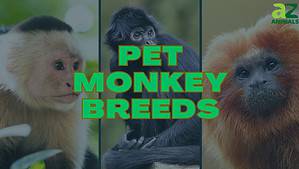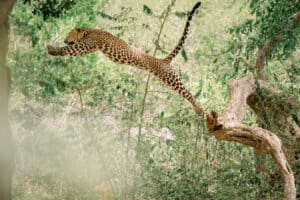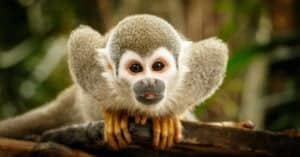Movies make it look like monkeys love bananas and eat mostly bananas to survive. But is this true, or have movies and cartoons misled us all this time? Let’s find out what monkeys really eat.
Do Monkeys Eat Bananas in the Wild?
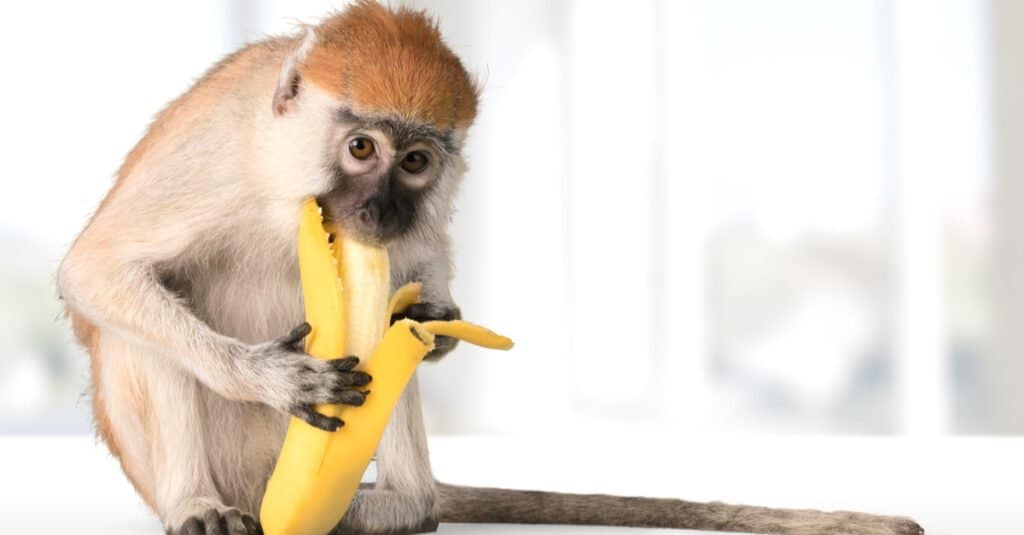
Monkeys may eat wild bananas, but they seldom eat the domestic Cavendish banana that people eat.
©Billion Photos/Shutterstock.com
Dr. Katharine Milton is a UC Berkeley professor of physical anthropology who says that monkeys do not eat bananas as much as most people think. This choice is because of how the bananas taste. The bananas we buy in supermarkets and shops are not found in the wild, as they are cultivated domestic plants. Instead, the bananas we eat are a variety called the Cavendish. This variety has no seeds, which wild bananas have. The ancestor of the Cavendish variety is the Musa acuminate, which has a similar shape but does not taste as good.
Monkeys really do eat bananas in the wild, similar to the ones we eat, but they are different from supermarket bananas. The bananas we eat are too sweet for monkeys and are only good as occasional treats. Because of this, zoos ban visitors from feeding Cavendish bananas to monkeys, which can lead to damaging their teeth and even diabetes. Monkeys also avoid eating Cavendish bananas, preferring other fruits, like grapes. But besides this, monkeys shouldn’t eat bananas as they are too sugary and are easily absorbed. Monkeys are designed to eat foods high in fiber that take longer to digest.
What Do Monkeys Eat?
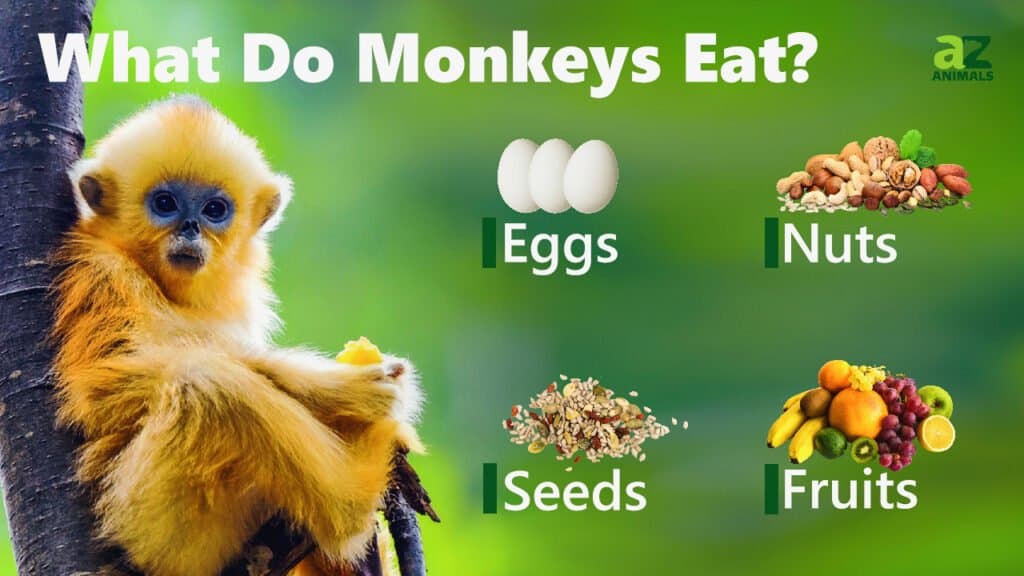
Monkeys are omnivorous animals and prefer eating a range of foods. Their regular diet often includes nuts, fruits, seeds, eggs, insects, and lizards. Depending on the monkey species and location, they have adapted their diets to the foods available. Some species are frugivores, which means they mainly eat fruit. Some species are insectivores, which means they eat insects, and some are insectivores and frugivores.
Some monkey species have specialized digestive systems to process specific foods. For example, howler and colobus monkeys are leaf eaters and have long digestive tracts to absorb tough-to-digest leaf nutrients. In addition, these monkeys have multi-chambered stomachs that allow specialized fermentation of plant matter. Capuchin monkeys eat plants, insects, and even other small animals. The gelada monkey is a herbivore and the only monkey that primarily eats grass. Some species of monkeys, like chimpanzees, are cannibalistic. This cannibalization happens when males kill rival males, or a pregnant female needs specific nutrients.
The diets between wild monkeys and city monkeys differ because of the types of foods that are available. Wild frugivores and omnivore monkeys eat fruits like bananas, mangoes, fleshy fruits, pomes, drupes, grass, leaves, flowers, buds, seeds, gum, and nectar. On the other hand, wild insectivorous, omnivorous monkeys eat insects, snails, and other invertebrates. Additionally, wild omnivore and obligate carnivore monkeys eat eggs, birds, lizards, bats, squirrels, and other vertebrates like smaller monkeys. City monkeys eat fruit from trees, food handed to them by humans, and food found in the trash.
Where Do Monkeys Find Their Food?
Most food monkeys feed in their immediate territory. If monkeys don’t find the food they require, they will move to greener pastures until they locate food sources to sustain themselves. Monkeys prefer eating nearby foods to give them the sugar, carbohydrates, fiber, and protein they need. Old World monkeys grasp and pluck at the fruit with their opposable thumbs while swinging from tree to tree. They are also intelligent foragers. Old World monkeys also have anatomical advantages, like pouches in their cheeks where they can store food. In contrast, New World monkeys, like capuchins, are intelligent. Instead of storing food, they use rocks and other complex tools to crack open shell nuts and to reach ants and termites in their nests.
What Do You Feed Monkeys In Captivity?

It is essential to feed captive monkeys a diet rich in all the necessary nutrients.
©Nick Fox/Shutterstock.com
Guardians must ensure they feed captive monkeys a diet rich in all the necessary nutrients, depending on the species and size. This menu must contain an adequate food quantity, quality, and variety. Zookeepers and monkey owners should also understand that monkeys are natural foragers and feed socially. This knowledge should affect the way they care for captive monkeys.
Dietary Plan
The monkey’s keeper should create a dietary plan based on the species, size, condition, health, and reproductive status. Additionally, the keeper must monitor the effects of the dietary plan and make changes according to certain factors, like the weight or reproductive responses of the monkey. Pet owners or guardians should feed fresh, natural foods to their monkeys. But you can give them manufactured foods when necessary, including supplements containing proteins, vitamins, and minerals. New World monkeys, specifically marmosets and tamarins, commonly have deficiencies in vitamin C and vitamin D3. In contrast, all primates suffer from a lack of calcium, vitamin D3, and vitamin A.
Roughage
Monkeys also need enough roughage in their diets. Fiber-rich foods, like leaves and pelleted foods, provide this roughage. If their diet has enough roughage, monkeys will not suffer from diarrhea, which often occurs when they overeat. Foods that are high in fiber also maintain good dental health in monkeys. Keepers should avoid feeding milk and dairy products to monkeys, as this may result in diarrhea and bloating. The same applies to sugary foods, which can cause poor dental health and diabetes.
Which Foods Are Poisonous For Monkeys?
Foods that are poisonous to monkeys are the devil’s trumpet or angel’s trumpet. Certain pesticides, like ones that contain organophosphates, are toxic to monkeys. For example, pesticides containing organochlorine DDT cannot lead to fatality in monkeys but affect fertility. In addition, foods that become moldy, like seeds, grains, fruit, meat, cheese, and bread, may contain mycotoxins, which are poisonous to monkeys.
The photo featured at the top of this post is © iStock.com/Akash Kaparaveni
Thank you for reading! Have some feedback for us? Contact the AZ Animals editorial team.



